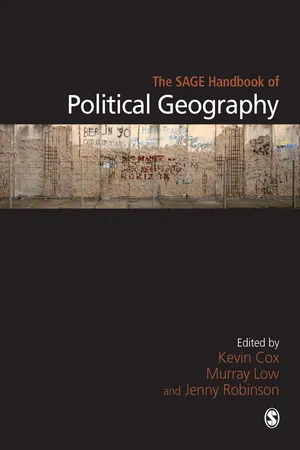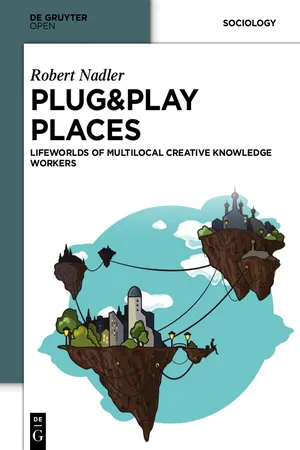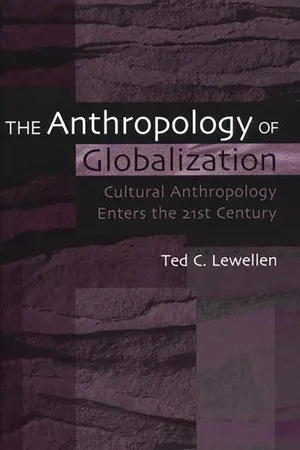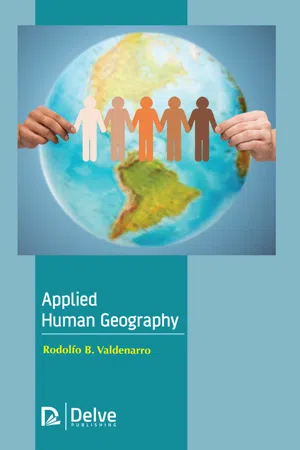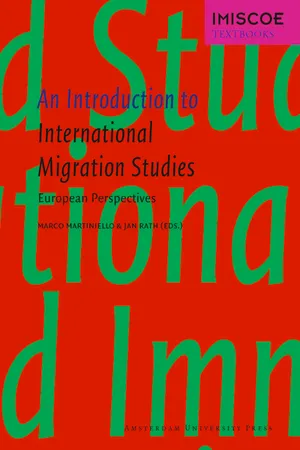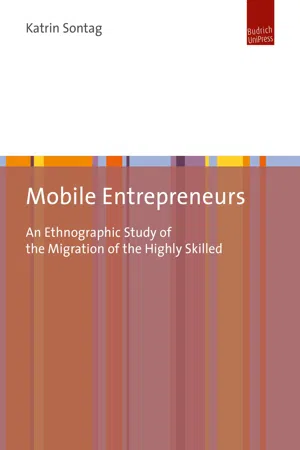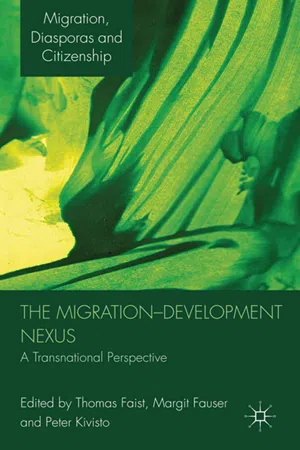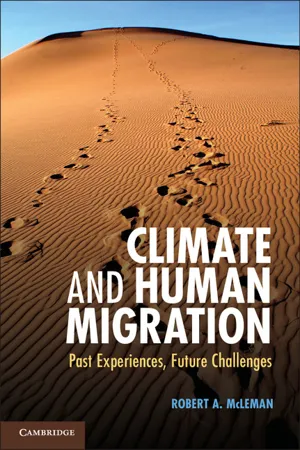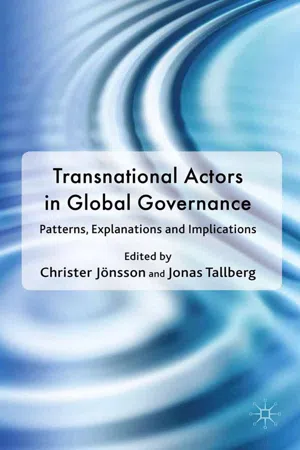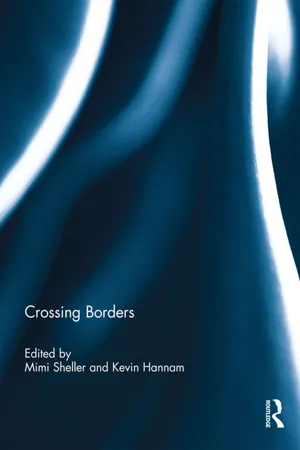Geography
Transnational Migration
Transnational migration refers to the movement of people across national borders, often involving the crossing of multiple countries. It is characterized by the maintenance of social, economic, and cultural ties across these borders, leading to the formation of transnational communities. This phenomenon is influenced by factors such as globalization, economic disparities, and political instability, and has significant impacts on both sending and receiving countries.
Written by Perlego with AI-assistance
Related key terms
1 of 5
10 Key excerpts on "Transnational Migration"
- eBook - PDF
- Kevin R Cox, Murray Low, Jennifer Robinson, Kevin R Cox, Murray Low, Jennifer Robinson(Authors)
- 2007(Publication Date)
- SAGE Publications Ltd(Publisher)
29 Transnationalism and (Im)mobility: The Politics of Border Crossings R a c h e l S i l v e y , E l i z a b e t h A . O l s o n a n d Y a f f a T r u l e o v e INTRODUCTION The transnational dynamics of socio-spatial mobil-ity and immobility are intrinsically both political and geographic. Yet only recently has research on Transnational Migration begun to engage explicitly with the central concerns of the disciplinary sub-field of political geography. This chapter provides a review of the emerging Transnational Migration literature as it speaks to central concerns within political geography. In particular, the discussion centers on the geographic migration research that is framed in terms of transnationalism and feminist political geography. The primary goals of tracing this literature are to explore the contributions of critical cross-border migration studies for political geography, and to identify the parallel advances in both migration studies and political geography. Political geography in the 1980s and 1990s expanded its core conceptualizations of ‘the political’. Specifically, while maintaining the subfield’s longstanding concerns with the state, electoral politics, and the structures of capitalism, research has placed increasing emphasis on the role of human agency and everyday actions in producing and conceptualizing those structures (Marston, 2000). Studies of transnational mobility have represented a similar shift in emphasis. That is, whereas the nation and national boundaries have figured prominently in conventional international migration research, more recently migrants’ cre-ation and maintenance of trans national ties have become focal points of research (Glick Schiller et al., 1992). The attention to the roles of migrants in creating and maintaining ‘multi-stranded ties’ across national boundaries mirrors political geog-raphy’s expanding understanding of the scales, subjects, and processes that constitute the political (Nagar et al., 2002). - eBook - PDF
Plug&Play Places
Lifeworlds of Multilocal Creative Knowledge Workers
- Robert Nadler(Author)
- 2014(Publication Date)
- De Gruyter Open Poland(Publisher)
Multilocality research has emerged in the social sciences of the German speaking world (Germany, Switzerland and Austria) in order to understand how people who circulate between different places on a regular basis relate to this circulation and to the places involved. 4.1 Transnationalism Since the early 1990s, the notion of transnationalism spread in social sciences. Studies that deal with the lifeworlds of people living ‘in-between’ two or more nation-states increasingly refer to this term (Brickell & Datta, 2011a). In particular, migra-tion scholars have adopted the concept in order to understand the new forms of cir-cular migration that have occurred in the frame of increasing integration of global (labour) markets. Principally, transnationalism is about the various linkages that mobile individuals develop to different nation-states and national societies. The pio-neers of current transnationalism research, Glick Schiller et al. (1992: 1f.), defined transnationalism as ‘ the processes by which immigrants build social fields that link together their country of origin and their country of settlement. Immigrants who build such social fields are designated ‘transmigrants’. Transmigrants develop and maintain multiple relations – familial, economic, social, organizational, religious, and political – that span borders. Transmigrants take actions, make decisions, and feel concerns, and © 2014 Robert Nadler This work is licensed under the Creative Commons Attribution-NonCommercial-NoDerivs 3.0 License. 103 Routes: Understanding Mobility develop identities within social networks that connect them to two or more societies simultaneously ’. Glick Schiller et al. (1992) studied migrant groups from the Philippines and several Caribbean Islands in New York. They found that the transnationalism concept is subject to six premises. - eBook - PDF
The Anthropology of Globalization
Cultural Anthropology Enters the 21st Century
- Ted C. Lewellen(Author)
- 2002(Publication Date)
- Praeger(Publisher)
4 The idea of transnationalism has been Transnationalism: Living Across Borders 151 so fruitful that it has become a standard, along with the term "transmigrant," within the more general field of migration studies. Multinational People and Deterritorialized Nations A transnational migrant is one who maintains active, ongoing intercon- nections in both the home and host countries and perhaps with communities in other countries as well. These relationships may be economic, social, cul- tural, or political; as often as not, they are all of these at once. Even though the migrant may take up permanent residence and achieve legal citizenship within the host country, this does not imply a break with the home society. Indeed, immigrants may retain the term "home" for the country of origin even into a second or third generation of legal citizenship in the new country. It is evident that transnationalism is thus a concept admitting of degrees; it may be intense—with constant phone calls, money transfers, back-and-forth travel, and participation in home politics and businesses—or relatively restrained, involving only occasional contacts. Ethnological study of transmigrants has only been going on for less than two decades so it is not yet clear if transnationalism will be reproduced over many generations; there is, however, good reason to believe that it will become an enduring al- ternative, competing with, but not replacing, assimilation. Living across borders, transnational migrants break down the identifica- tion of nation and state and give rise to the paradoxical concept of deterritorialized state or, more accurately, deterritorialized space. This postmodern concept of space can be quite complex. It is basically social space, that is, it is defined in terms of social networks rather than in relation to political or geographical boundaries. - eBook - PDF
- Rodolfo B. Valdenarro(Author)
- 2019(Publication Date)
- Delve Publishing(Publisher)
When the new transient arrives, it is simpler to get settled in, to comprehend the traditions of the new spot, and to look for some kind of employment on the off chance that they definitely know individuals in the spot they settle. Relocation is a ceaseless procedure that has been the subject of political discussion around the world. Movement has demonstrated a solid upward pattern, be it of individuals who have left their countries intentionally for financial or different reasons, or of the individuals who have been driven away from their homes (outcasts, dislodged people, and so forth.). Overseeing human portability is one of the best difficulties for goal nations around the world, in created and creating nations. 9.2. TYPES OF MIGRATION Relocation can be grouped in a few different ways. It is typically arranged as in the subsection. 9.2.1. By Political Limits In view of political points of confinement and the limits crossed, for example, locale, districts, state outskirts and worldwide limits, further recognized as the spots of source and goal. A broadly perceived qualification exists among interior and global relocation: 1. Internal migration Movement happening inside a nation from intersection political limits, either inside a state or between states, regardless of whether urban to rustic, urban to urban, provincial to country, or country to urban. The term related with vagrants touching base at their goal is “in-transients,” and with those leaving Applied Human Geography 188 their place of source is “out-vagrants.” This type of relocation likewise incorporates development between towns, squares and locale. 2. International migration Movement happening crosswise over nation limits. Such vagrants are known as outsiders (coming into a remote nation) and wanderers (leaving their own nation). This additionally incorporates mainland to-landmass relocation. - eBook - PDF
An Introduction to International Migration Studies
European Perspectives
- Marco Martiniello, Jan Rath(Authors)
- 2012(Publication Date)
- Amsterdam University Press(Publisher)
These studies have found that only a small propor-tion of migrants engage in regular migrant transnationalism, although there are important discrepancies between the economic, social and political spheres. Mapping migrant transnationalism Parallel to the debate regarding the newness, scope and durability of migrant transnationalism, there has been a process of categorising and conceptualising the practices, networks and arenas of migrant transnationalism. Concepts such as transnational social spaces (Faist 2000; Pries 2001), transnational social fields (Glick Schiller 2005) or transnational social formations (Guarnizo 1998) seek to capture the multi-layered cross-border sites, structures and institutions of migrant transnationalism (Levitt and Jaworsky 2007). mapping exercises In terms of categories, a number of mapping exercises have divided migrant transnational practices according to theme, intensity, type of actor and network or relationship with state institutions and public policy. With regard to themes, the distinction between economic, so-cial and political migrant transnationalism presents a more nuanced analysis of the field (Portes et al . 1999). Some types of practices fit neatly into these categories, whereas others overlap. Other practices warrant additional categories, as in the case of transnational religious networks of migrants (Levitt 2007). remittances Among the main practices analysed within migrant economic trans-nationalism are the remittances that migrants send back to their fami-lies, the foreign direct investment of migrants and diasporas and the cross-border business networks involving migrants (Portes et al . 2002). While remittances are usually analysed in terms of migrants 112 EVA ØSTERGAARD -NIELSEN and their homelands, migrant business networks may have a wider re-gional or even global span, as in the case of the Fujianese (Chinese) migrants (Pieke et al . 2004). - Available until 15 Jan |Learn more
Mobile Entrepreneurs
An Ethnographic Study of the Migration of the Highly Skilled
- Katrin Sontag(Author)
- 2018(Publication Date)
- Budrich UniPress(Publisher)
69 5 Movement: Migration or Mobility? I am sitting in the entrance area of a co-working space in black leather seats opposite the reception counter. People keep coming in through the revolving door. Opposite the door is an elevator, behind it a huge hall leading to different offices. A young man rides through the hall on a little lightweight scooter – also an invention by a Swiss startup. My interview partner comes up to greet me right on time, wearing a hooded sweater and jeans. He intro-duces himself by his first name and immediately uses the more familiar German form of addressing me. We settle at a café for a second breakfast. 18 5.1 Forms of Migration The people I encountered could be classified as migrants. Yet there are dif-ferent ways in which people move over the course of a lifetime. Common definitions of migration differentiate between migration, transmigration, circular mobility, multilocal living or second generation migrants. 1. Migration: Limmer and Schneider define migration as “permanent trans-national mobility” (Limmer & Schneider, 2008, p.21). 2. Transmigration is a movement from one place to the next and on to the next, “a permanent movement across borders without a clear notion of geographical destination” (Limmer & Schneider, 2008, p.21). 3. Circular mobility “includes recurring forms of mobility, with mobile subjects returning, after times of absence, to their place of origin, respec-tively their permanent residence” (Limmer & Schneider, 2008, p.21). Commuting and travelling would also be ranged under this heading. 4. Multilocality is the simultaneous existence of two or more offices or liv-ing places in different locales. Multilocal living even more specifically describes living in different places at the same time: “Multilocal living means organizing daily life across several living places” (Hilti, 2009, p.81, my translation). 5. People whose parents migrated also appear in some studies as migrants or second generation migrants. - eBook - PDF
The Migration-Development Nexus
A Transnational Perspective
- Thomas Faist, Margit Fauser, Peter Kivisto(Authors)
- 2011(Publication Date)
- Palgrave Macmillan(Publisher)
Moreover, there are divergent assessments of migrants’ transnational ties – they can be considered beneficial regarding development cooper- ation, but often also viewed suspiciously by immigration states when it The Migration–Development Nexus 11 comes to political activities. While former colonial powers with long experience in penetrating developing countries have seized quickly upon the idea of co-development and the engagement of diasporas for development, others, often characterized by historically less intense international ties, have only recently started to think about such mod- els. Examples for the former category are national states such as France, the UK, Spain and the Netherlands, for the latter Germany, Austria and Sweden. Hence, manifold new forms and assessments of transnational cir- culations reaching across state borders have emerged. Accordingly, a transnational perspective is required to link both development and migration studies. Such a perspective has to account for processes of cross-border transactions which may concatenate in transnational fields or spaces. These consist of combinations of social and symbolic ties and their contents, positions in networks and organizations, and networks of organizations that cut across the borders of at least two national states. In other words, the term refers to sustained and continuous pluri-local transactions crossing state borders. Most of these formations are located in between the life-world of personal interactions on the one hand, and the institutionalized fields of the economy, polity, law, science and reli- gion on the other hand. The most basic element of transnational social formations is transactions, that is, bounded communications between social agents such as persons. More aggregated levels encompass groups, organizations and firms. From this perspective, it is an empirical ques- tion whether such transnational transactions are of global or regional reach. - eBook - PDF
Climate and Human Migration
Past Experiences, Future Challenges
- Robert A. McLeman(Author)
- 2013(Publication Date)
- Cambridge University Press(Publisher)
For migrants travelling long distances to settle in new and unfamiliar places, migration may be a long and arduous process, with integration into the destination population never completed within the migrant’s own lifetime, but continued by subsequent generations. The migration process as experienced by the individual does not exist in a vacuum; it is nested within larger sets of dynamic and interconnected cultural, economic, envi- ronmental, political, and social processes that shape human behavior more gener- ally. A decision to migrate today may be the product of any number of antecedent 2 Why People Migrate 2.2 Basic Assumptions of Modern Migration Research and Their Origins 17 conditions and events. And, once acted upon, the decision to migrate generates new sets of risks and opportunities not only for the migrant, but for his or her social net- work, and for the sending and receiving communities as well. Migration is more than simply a movement across physical space; it is a change in the trajectory of an indi- vidual and those connected to that individual through social space. The aim of this chapter is to provide the nonspecialist a clear overview of current scholarly understanding of the migration process and to introduce a set of basic the- ories, concepts, and terms that: Have been used in a wide variety of settings to explain and interpret how migration deci- • sions are made and the factors that shape migration behavior generally; Can be used to describe and analyze in a systematic fashion known examples of migration • related to droughts, floods, extreme weather events, and other climate-related phenomena; and Will be combined in • Chapter 3 with scholarship that considers human vulnerability and adaptation to climatic variability and change in order to create a conceptual framework that shows the interactions between climate and migration within the context of an adaptive human-environment system. - eBook - PDF
Transnational Actors in Global Governance
Patterns, Explanations and Implications
- Christer Jönsson, Jonas Tallberg(Authors)
- 2010(Publication Date)
- Palgrave Macmillan(Publisher)
134 7 Limits to Transnational Participation: The Global Governance of Migration Sara Kalm International migration is a conspicuous manifestation of contemporary globalization. 1 As a result of improved and strengthened transborder interconnections, the numbers of migrants are growing at an accel- erated pace and now comprise around 200 million people. Migratory movements have also expanded geographically so that all states and regions in the world are now affected at some point of the migratory chain – as destination, sending, or transit regions. In other issue-areas that involve movement across borders – such as trade, climate change, or contagious diseases – states have developed institutionalized forms for cooperation in order to meet these chal- lenges more efficiently. But this has not been the case for international migration, which is usually characterized by the absence of multilateral institutional frameworks (Bhagwati, 2003; Ghosh, 2007). 2 However, the past few years have seen the evolvement of bottom-up structures for global migration governance (Betts, 2008: 1). A wide array of organizations and forums for consultation and dialogue are now han- dling various aspects of migration. The complex system of institutions that are emerging at the bilateral, regional, and global levels are distin- guished by the continual central role of the state, while other actors enjoy very limited access. In fact, as the term “global” in the context of governance is usually meant to signif y the increased inf luence of trans- national actors (Lipschutz, 1996: 1; Pattberg, 2006: 4), it has been sug- gested that the governance of migration should more appropriately be described as “international” – given that states are still unquestionably the paramount actors (Channac, 2007). In contrast to most other chap- ters of this volume, this one therefore engages with a case which has so - eBook - PDF
- Mimi Sheller, Kevin Hannam(Authors)
- 2018(Publication Date)
- Routledge(Publisher)
5. Conclusion Politics, as a result of migration-induced transnational practices, takes shape in transnational spaces within which ideas, people, technology, political forms, and strategies circulate at multiple levels. Our examples show how trends in global gov-ernance, national policy reforms, and individual and collective political remittances of all kinds inform and transform each other. Political remittances can potentially shape how migrants are incorporated into receiving country politics. What emigrants send back, in turn, affects the sending country ’ s politics and political attitudes more broadly. Moreover, political remittances have the potential to scale up and scale out. Once people ’ s attitudes change with respect to one scale of governance (local), parallel changes may migrate to another scale of governance (national or even international). CROSSING BORDERS 118 Hometown associations, ethnic organizations, and diaspora networks may all contribute to these processes by expanding the reach of some political remittances beyond the national boundaries of origin and destination countries. The diffusion of external voting, while primarily a state-led process that occurs in (not necessarily sequential or complete) stages, can also be understood along these lines. It reveals that the circulation of political remittances can be a highly variable and intermittent process – one which is shaped by the structure of opportunities and the strategic interests of sending countries (and even, to some extent, of the receiving ones). The implementation of external voting laws, on the other hand, raises questions about the in fl uence of political remittances on long-term sending states ’ engagement with citi-zens abroad. Indeed, though limited emigrant participation in home country elections is usually the norm, it can be interpreted in many different ways.
Index pages curate the most relevant extracts from our library of academic textbooks. They’ve been created using an in-house natural language model (NLM), each adding context and meaning to key research topics.
